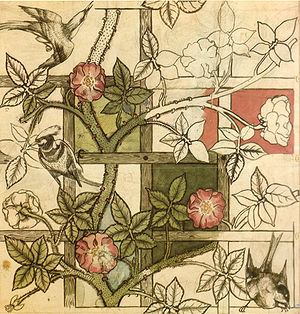
Back حركة الفنون والحرف Arabic ارتس اند كرافتس ARZ Изкуства и занаяти Bulgarian Art and Crafts BS Arts and Crafts Catalan Hnutí uměleckých řemesel Czech Y Mudiad Celf a Chrefft Welsh Arts and Crafts Danish Arts and Crafts Movement German Κίνημα Arts and Crafts Greek

The Arts and Crafts movement was an international trend in the decorative and fine arts that developed earliest and most fully in the British Isles[1] and subsequently spread across the British Empire and to the rest of Europe and America.[2]
Initiated in reaction against the perceived impoverishment of the decorative arts and the conditions in which they were produced,[3] the movement flourished in Europe and North America between about 1880 and 1920. Some consider that it is the root of the Modern Style, a British expression of what later came to be called the Art Nouveau movement.[4] Others consider that it is the incarnation of Art Nouveau in England.[5]
Others consider Art and Crafts to be in opposition to Art Nouveau.[6] Arts and Crafts indeed criticized Art Nouveau for its use of industrial materials such as iron. And as for Art Nouveau artists, the Arts and Crafts utopia was intrinsically contradictory: "the paradoxical confinement of the Arts & Crafts movement in an artisanal practice was completely out of step with the evolution of the status of the artist-decorator, but also with the democratic will of an art 'for the people and by the people' proclaimed by William Morris".[7] For example, while Henry van de Velde understood the social discourse of Arts and Crafts, he was not an unconditional disciple of the movement and ended up turning away from it, considering it as anachronistic and tinged with quixotism.[8]
In Japan, it emerged in the 1920s as the Mingei movement. It stood for traditional craftsmanship, and often used medieval, romantic, or folk styles of decoration. It advocated economic and social reform and was anti-industrial in its orientation.[3][9] It had a strong influence on the arts in Europe until it was displaced by Modernism in the 1930s,[1] and its influence continued among craft makers, designers, and town planners long afterwards.[10]
The term was first used by T. J. Cobden-Sanderson at a meeting of the Arts and Crafts Exhibition Society in 1887,[11] although the principles and style on which it was based had been developing in England for at least 20 years. It was inspired by the ideas of historian Thomas Carlyle, art critic John Ruskin, and designer William Morris.[12] In Scotland, it is associated with key figures such as Charles Rennie Mackintosh.[13] Viollet le Duc's books on nature and Gothique art also play an essential part in the esthetics of the Arts and Crafts movement.
- ^ a b Campbell, Gordon (2006). The Grove Encyclopedia of Decorative Arts, Volume 1. Oxford University Press. ISBN 978-0-19-518948-3.
- ^ Wendy Kaplan and Alan Crawford, The Arts & Crafts movement in Europe & America: Design for the Modern World, Los Angeles County Museum of Art
- ^ a b King, Brenda M. (2005). Silk and Empire. Manchester University Press. ISBN 978-0-7190-6700-6.
- ^ "Arts and Crafts movement | British and international movement". Encyclopedia Britannica. 4 August 2023.
- ^ Maingon, Claire (2018). "L'Art Nouveau en trois minutes". Beaux Arts Magazine.
- ^ Férré, Benjamin (2015). "L'inspiration Arts & Crafts". Coline Blot - Espace Saint-Cyprien,Toulouse.
- ^ Froissart, Rossella (2011). L'art ornemental d'Eugène Grasset : l'unité rêvée des arts à l'ère industrielle [The ornamental art of Eugène Grasset: the dreamed unity of the arts in the industrial era] (in French). Aix-Marseille University: HAL Open science (published 2019).
- ^ Brogniez, Laurence (2011). Ruskin en Belgique: passage en revue (1880-1930). Paris: Classiques Garnier.
- ^ Moses N. Ikiugu and Elizabeth A. Ciaravino, Psychosocial Conceptual Practice models in Occupational Therapy; "Arts and Crafts Style Guide". British Galleries. Victoria and Albert Museum. Retrieved 17 July 2007.
- ^ Cite error: The named reference
maccarthy2014was invoked but never defined (see the help page). - ^ Alan Crawford, C. R. Ashbee: Architect, Designer & Romantic Socialist, Yale University Press, 2005. ISBN 0-300-10939-3
- ^ Triggs, Oscar Lovell (1902). Chapters in the History of the Arts and Crafts Movement. Bohemia Guild of the Industrial Art League.
- ^ Sumpner, Dave; Morrison, Julia (28 February 2020). My Revision Notes: Pearson Edexcel A Level Design and Technology (Product Design). Hodder Education. ISBN 978-1-5104-7422-2.